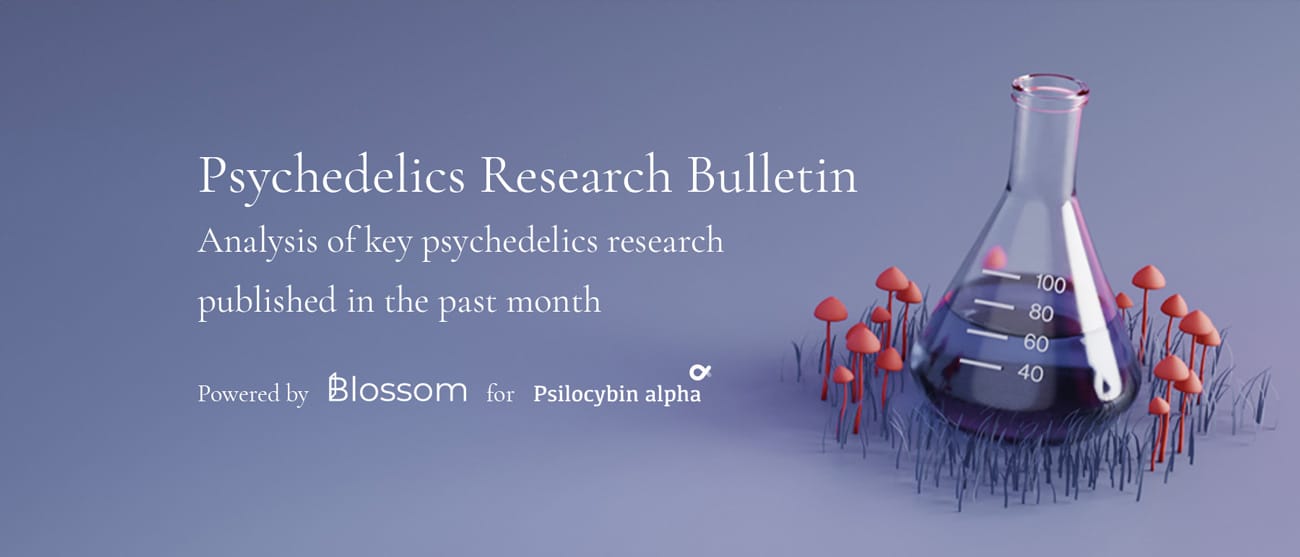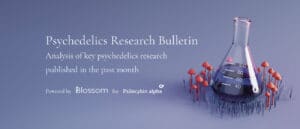Psychedelic research continued at pace during the summer of 2021. New research focusing on the risks of psychedelics, the benefits when treating addictions, knowledge of different groups about psychedelics (and much more) was published.
The transdiagnostic ability of psychedelics continues to be tested.
Randomized controlled trials (RCTs) for psychedelics
The goal of RCTs is to control for factors that aren’t under direct experimental control. There may be (unknown) differences between the participants in your study and by randomizing, assigning half to one ‘arm’ and the rest to the other, you can attempt to isolate these differences. Psychedelics have no problem with achieving this part of the design of RCTs.
It is also common for participants to be blinded to the experimental condition in a study, meaning they don’t know who got a medicine or other type of intervention. This part is much more difficult or near-impossible for psychedelic studies. A review argues that this has lead to an overestimation of outcomes and proposes several measures to tackle blinding issues. Giving the second group a small dose of psychedelics (or another drug) is one of the proposed measures.
If RCTs are even the right place to discover the effects that psychedelics have is questioned in an opinion paper. To better understand the effects on moral behavior, the authors advocate a complementary approach of culture-controlled trials that investigate this moral psychopharmacology under different social and cultural circumstances.
Another concern relating to the design of studies is the attrition rate: who drops out of a study? A survey of those who participated in an observational study (not an RCT) found that people didn’t drop out because of psychedelic-specific factors such as challenging experiences or prior dispositions towards psychedelics. This study addresses some of the concerns relating to who participated in, and finished, psychedelic studies.
Ayahuasca helps with stress, conflict, and self-compassion
There are currently less than a handful of clinical trials that have been conducted with ayahuasca. For one, the brew varies a lot per ceremony or tradition. Another possible reason might be the cultural stigma attached to ayahuasca (as with LSD) and the relative ease with which psilocybin can currently be studied. Still, there are many observational studies that help identify where ayahuasca could be of service.
A replication study, using the same design as an earlier study from 2018, found reductions in stress up to four weeks later. A positive impact on depression wasn’t found in the current group of participants. The study did also find improvements in life satisfaction the day after the ceremony, but not four weeks later. Similar positive immediate effects were found in a study that looked at self-compassion and self-criticism which were increased and decreased, respectively, the day after a ceremony. And another analysis of earlier data finds inconsistent effects on the personality trait Openness, something that was found to be increased in other studies.
How ayahuasca may help in resolving conflict is investigated in three case studies that dived deeper into the relational processes in ayahuasca groups of Palestinians and Israelis. The revelatory events during a ceremony led the participants to develop resistance towards the dominant Israeli culture, the urge to deliver emancipatory messages to other participants (through song), and later also to expand the practice to other Palestinians.
Psychedelics do not come without risks
Another understudied psychedelic is ibogaine. The root bark of the iboga tree has been used for centuries in rituals and at least for decades in helping people fight addiction. A review of 18 studies finds that there are significant risks, mainly to the heart, that present themselves both acutely and after treatment. Standardizing the amount of product used (which is difficult if using natural products), at least in research settings, is vital to understanding what the right therapeutic and (relatively) safe dose is.
Hallucinogenic-persisting perception disorder (HPPD) is a rare disorder that encompasses persisting visual disturbances after the use of psychedelics. A review argues that the current characterization in the DSM-V is not encompassing all aspects of HPPD and identifies 64 unique symptoms. Most of the symptoms overlap with Alice in Wonderland syndrome (AIWS) which relate mostly to distorted perception and disorientation.
Combining psychedelics with medication is something that should not be taken lightly. In the case of antidepressants (SSRIs), it could dampen the positive therapeutic effects, or could possibly lead to serotonin syndrome when combined with MDMA. But one combination to really stay away from is that with lithium. An analysis of online reports find that lithium and classical psychedelics have led to seizures (47%), and emergency medical treatment (39%). A review dives deeper into the risks related to serotonin and psychedelics.
The idea that everyone should be able to access psychedelics legally is questioned in an opinion paper that investigates two routes to legalization. When making psychedelics available for cultivation or noncommercial sharing, the authors argue that unreflective marketing, only promoting the benefits, may not indicate the (psychological) risks that come with taking psychedelics. However, one does need to take into account that a large percentage of the population has been using psychedelics already. Conversely, drug checking services now also find that within the illegal trade some more toxic substances and novel psychedelics are being sold.
How do care providers look at psychedelics?
Those that will need to administer psychedelics are slowly warming up to the potential they have. Still, many psychiatrists (and others in healthcare) are not aware of the current state of research. A survey study asked psychiatrists at two conferences about their knowledge (many aware of the promise) and opinions/concerns (lack of training, logistics, patients with contraindications) regarding psychedelic therapy. Those who worked more in research, knew more about psychedelics, or were less concerned about the addictive potential scored higher in their beliefs on the effectiveness of psychedelic-assisted therapy.
More specifically, an interview study looked at the attitudes of cancer healthcare workers towards psychedelic-assisted therapy. In general, they were open to the concept, viewed it as an innovative approach, and acknowledged their responsibility towards alleviating suffering in advanced cancer patients. However, this view was also met with caution and highlights the need for further research to ensure efficacy and safety. Similar sentiments were found when interviewing five palliative care workers.
Psychedelics show promise in treating addiction to alcohol and drugs
One of the most successful and widely known ways of treating addiction is with a twelve-step program, which is provided by Alcoholics Anonymous (AA). A key pillar of the program is total abstinence of any drug (with the possible exception of caffeine). An opinion paper argues that making another exception for psychedelics may lead to synergies between the program and the therapeutic use of these substances. Although controversial, the founder of AA (Bill Wilson) did himself have positive experiences with psychedelics.
A large scale survey study finds that ayahuasca use is both strongly and consistently associated with very low (or even abstinence from) drug or alcohol use, with and without prior substance use disorders. The study covered 40 countries and participants indicated both the frequency of ayahuasca and use of alcohol, those who drank ayahuasca more often were more likely to drink less alcohol. Although observational, meaning it was no RCT as discussed before, it does provide good preliminary evidence for ayahuasca’s effect on drinking.
Earlier we talked about the risks of ibogaine and this is one of the main drivers for researchers to find related compounds that come with fewer of those risks, whilst still providing therapeutic benefits. A preprint (meaning no peer review has been done yet) argues that oxa-ibogaine alkaloids may have this coveted combination of characteristics. The rats in the study showed acute and long-lasting suppression of morphine self-administration in response to both single and repeated dosing regimes.
Ketamine remains the most studied ‘psychedelic’
Ketamine is not considered a classical (serotonergic) psychedelic and has a long history of being used as an anaesthetic. At the dosages being used in research, there are acute psychedelic (or dissociative) effects, and there are long-term positive effects from ketamine treatments. Because of its wide and less restricted access, ketamine has been studied in more people than all other psychedelics combined.
Because of the large sample size, a review was able to find if ketamine treatment for depression led to worse outcomes for those with a history of psychotic symptoms. The review found 41 cases and showed that the available literature does not support the assumption that ketamine will exacerbate psychotic symptoms in predisposed patients.
More debates are being had about the effectiveness of esketamine (one ‘half’ of ketamine). A pooled analysis, bringing together results from multiple studies, finds that for patients that don’t respond immediately to treatment for depression, continued treatment may still be beneficial. Another analysis of the same original study (TRANSFORM) finds that those who also have anxiety (72% of participants) respond just as well to treatment as those without. Another pooled analysis (this time of the ASPIRE studies) finds that esketamine improves depressive symptoms and suicidal ideation. These effects were found immediately after treatment and up to 25 days later. Finally, a review of 10 studies finds that only one short-term study finds benefits of esketamine over only antidepressants for depression, but does find a longer time to relapse and sustained improvements.
Ketamine has not been used in the treatment of PTSD often. A double-blind study investigated through which mechanisms it could work and compares the effects to that of midazolam (a sedative). Both midazolam and ketamine improved symptoms, which were most reliably predicted by the reduced excitation of the amygdala and ventromedial prefrontal cortex (vmPFC) during the processing of socio-emotional threat signals, but only ketamine-related improvement was associated with increased top-down inhibition of the amygdala by the vmPFC.
The rest of the studies in July and August 2021
A study in mice finds the possible route through which MDMA reverses social deficits, increased activity in the nucleus accumbens (NAc). The authors argue that enhancement of 5-HT release or direct 5-HT1b receptor activation may help with treating sociability deficits commonly found in those with autism spectrum disorder (ASD).
The mechanisms through which psychedelics work in the long term are under constant investigation. A survey study finds that among people of color, psychological flexibility mediated the relationship between acute psychedelic effects (acute insight & challenging experiences) and decreases in racial trauma.
Psychedelics may provide a way to treat (traumatic) brain injury (TBI). A review proposes that psychedelic pharmacotherapies may fundamentally alter the future of brain injury treatment via modulation of neuroinflammation, neuroplasticity, hippocampal neurogenesis, and brain complexity.
How psychedelics change the connectivity in brains remains a topic where we can learn much more. A brain modelling study finds the topographic effects (where) LSD changes functional connectivity (FC) in the brain, via the modulation of serotonin 2A pyramidal cells.
Making psychedelics at scale (at low costs) is paramount and a new synthesis method using quorum-sensing-controlled bacterial small RNA increased the yield of psilocybin biosynthesis in E. coli by 302.9% without affecting cell growth.
Finally, an interview study asked recreational users of psychedelics why they used psychedelics. With all the focus on therapeutic use, it may be easy to forget the reasons why most people take psychedelics. Recreational use is mostly centred around curiosity and ‘having fun’ and less, but still so, about decreasing ego-inflated pathology and increasing existential awareness. Those who use psychedelics have a 23% lower odds of heart disease and a 12% lower odds of diabetes in the past year (though correlation doesn’t imply causation).
The Research Bulletin is powered by Blossom, a psychedelic research database. Blossom helps you find scientific insights in this blossoming era of psychedelic research. Find the latest papers in the database, search with useful filters, and learn about new topics in high-level reports.





